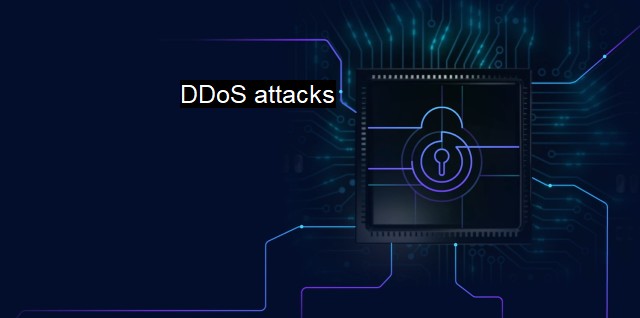What are DDoS attacks?
The Threat of Distributed Denial of Service (DDoS) Attacks: Examining the Anatomy of the Attack, Techniques Used by Cybercriminals, and Strategies for Mitigation
A Distributed Denial of Service (DDoS) attack is a common, aggressive and malicious effort, popular in the world of cybercrime, to disrupt normal network traffic and impair the performance of online services, web resources, applications or an entire network. It usually occurs when an attacker, or a group of attackers, overwhelms a target's network, internet connection or systems with a deluge of internet traffic. The objective of the operation is simple: to flood the targeted system with an enormous volume of requests, thereby disrupting the regular functioning and preventing legitimate users from accessing targeted resources.In a DDoS attack, multiple compromised computers, known as a botnet, are used to execute the assault on the target. Each individual computer within this army of machines, which can be found globally, acts as a source for the DDoS strike. This scattered nature poses the investigating team with the most significant challenge - identifying the source of the disruption with hundreds or even thousands of devices implicated becomes a Herculean task. The vast geographical spread of these attacks further complicates matters, making DDoS investigations intricate and arduous to deal with comprehensively.
Differentiating between the different types of DDoos attacks becomes critical for cybersecurity professionals. Key distinctions appear when we talk about volume-based attacks, protocol attacks and application layer attacks. Volume-based strikes overload a system with diversionary data, occupying all the available bandwidth and effectively barring any legitimate traffic from getting through. Protocol attacks, on the other hand, primarily attack infrastructure; they consume all available processing capacity with seemingly real requests, leaving actual requests with nowhere to go. Application layer attacks lie on the more sophisticated end of the spectrum, targeting particular applications or services within the target's domain, bypassing conventional detection mechanisms, leaving the targeted systemunderwhelmed.
Efficient preventing mechanisms have become invaluable in the cybersecurity arena. With DDoS attacks becoming more potent and varied, stronger and more rigorous protective measures have never been more critical. Organizations should endeavor to maintain comprehensive and continually updated inventories of their network resources, with a specific focus on those that directly touch the internet, to identify malicious traffic swiftly.
Highly effective commercial antivirus software protect organizations by identifying malicious code and suspicious network activity, thereby mitigating potential risks. While detecting an ongoing DDoS attack can be particularly challenging due to the overwhelming amount of traffic, virus software focused on behavior patterns helps discern ominous spikes from genuine high traffic.
Organizations also use firewalls, intrusion prevention systems (IPS) and network architecture capabilities to protect themselves. These strategies boost detection and mitigation efforts, identifying attacks in their primary stages and thwarting them, consequently enabling organizations to mitigate the damage caused.
DDoS attacks, owing to their capacity to scale exponentially, pose a significant potential threat to a vast array of companies, from multinational entertainment conglomerates to small e-commerce start-ups. Any organization depending on online services and resource availability automatically becomes a potential target. DDoS attacks are also commonly employed to divert cybersecurity resources from other malicious activities, ranging from data theft and system intrusion to malware installation, making it imperative that all entities remain vigilant and well-fortified.
In summation, DDoS attacks represent a significant danger to contemporary cybersecurity efforts. Their varied nature and alarmingly escalating efficiency necessitate investment in competent antivirus programing and cybersecurity infrastructure. Comprehensively recognizing and understanding conducting mechanisms behind these attacks is the foremost objective in their mitigation. Increased investment in effective defensive measures and careful system architecture planning are vital in combating DDoS attacks.

DDoS attacks FAQs
What is a DDoS attack?
A DDoS (Distributed Denial of Service) attack is a cyber-attack in which an attacker overloads a targeted website or server with traffic, rendering it inaccessible to its intended users.How does a DDoS attack work?
In a DDoS attack, a hacker typically hijacks tens of thousands of computers or IoT devices, forming a network known as a "botnet." The botnet then sends a massive amount of traffic to the targeted server, overwhelming it and making it inaccessible to legitimate users.How can I protect my website from DDoS attacks?
There are several ways to protect your website from DDoS attacks, such as using a reputable web hosting provider, implementing firewalls and content delivery networks (CDNs), and using anti-DDoS software or services. It's important to regularly update your security systems and monitor your web traffic for any suspicious activity.What should I do if my website or server is under a DDoS attack?
If your website or server is under a DDoS attack, you should contact your web hosting provider or IT department immediately. They can help you mitigate the attack and restore access to your website or server. In some cases, you may need to temporarily shut down your website or server to prevent further damage while the attack is being addressed.| | A | | | B | | | C | | | D | | | E | | | F | | | G | | | H | | | I | | | J | | | K | | | L | | | M | |
| | N | | | O | | | P | | | Q | | | R | | | S | | | T | | | U | | | V | | | W | | | X | | | Y | | | Z | |
| | 1 | | | 2 | | | 3 | | | 4 | | | 7 | | | 8 | | |||||||